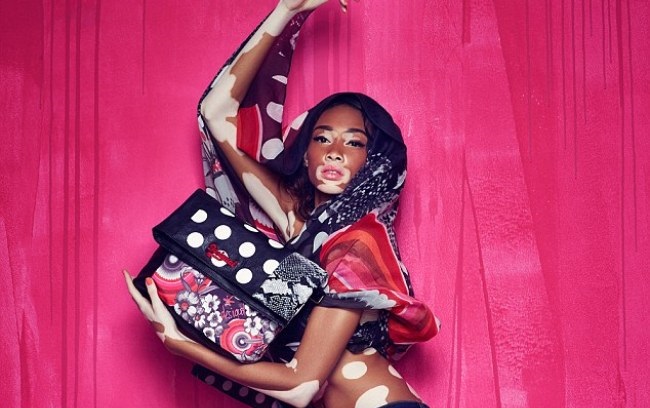Walk down the street, and strangers’ eyes will make you challenge your own interpretation of beauty. Luckily, many people with vitiligo are constantly working toward redefining the modern understanding of ‘beauty,’.
Visibility to vitiligo is getting better; thanks to models like Winnie Harlow and Amy Deanna who brought skin diversity in the adverting world and we witnessed some popular brands celebrating some of our common “imperfections.” Recently launched Rebecca Violette, a fashion label, went extra mile in this direction.
Rebecca Violette was launched with a mission to create wearable art that challenges society’s perceptions of visual difference. Though the brand collection could be worn by anyone, what was interesting to notice that Rebecca Violette used models with vitiligo as fashion influencers to promote the brand on social media. It felt as if fashion was being used as a tool of empowerment and celebration of difference. Rebecca Violette is not the only brand that has started looking beyond the per-perceived notion of beauty. Another fashion brand from the United Kingdom, Missguided, recently installed mannequins with vitiligo across its retail stores.
However, when we were younger, it was a much different story. We all, at some point or another, must have felt strange and uncomfortable around people, mostly due to lack of representation. Thankfully, that’s changing. And, this change is for good!
How far have we come?
Thanks to Winnie Harlow who, after her successful America’s Next Top Model (2014), was first featured in Diesel’s high-energy campaign. It was the first time when a girl with vitiligo was featured in any brand campaign. The ad aimed to promote tolerance, equality and unconditional love. The next in line was Say Something Nice campaign from Desigual. Harlow was also the brand ambassador for the Spanish brand. Subsequently, Marc Jacobs too featured a model with vitiligo in their campaign. The other fashion brands that have included vitiligo in their advertising (some way or other) are Parfait and Aliesha Renea.
Slowly, mainstream beauty brands too woke up from the unrealistic standard of beauty. CoverGirl’s latest ad for its TruBlend foundation featured Amy Deanna, a black model with vitiligo. On the other hand, the ‘#ShowUs’ campaign by Dove featured women who stand up for their own beauty and redefine “beautiful” by breaking away from traditional standards. The campaign spoke straight to hearts of all living with vitiligo.
Along with other brands, Aerie (a lingerie retailer and intimate apparel brand) and Gillette Venus also jumped on the positive body image movement. The brand, in its latest campaign, challenged conventional beauty standards and featured models with vitiligo.
.@Aerie diversifies its representation by showing models with Type 1 diabetes, vitiligo, and more https://t.co/aHI3PGujTc pic.twitter.com/Dsx4qX3WBr
— HelloGiggles (@hellogiggles) July 11, 2018
Recently, developing economies too have also started hiring models with vitiligo. While YBP Cosmetics recently has become the first Indian brand to hire Shantanu Gosavi (India’s first model with vitiligo), Sam Gonçalves was signed for a brand campaign by Kanui (a Brazilian, Sport-Fashion brand). Primark’s latest brand campaign is also a step further in celebrating skin diversity.
How can vitiligo friendly advertising help?
With vitiligo friendly advertising, you can notice a change in beauty and fashion world’s carved-in-stone beauty standards. Advertisements featuring vitiligo models can help many vitiligo fighters embrace their own uniqueness. No matter what is perceived as “normal,” these ads can help them find beauty and confidence in their skin.
The Final Word
Thanks to vitiligo’s presence in mainline advertising, now we have a certain level of respect involved with the conversation around body positivity. These ads are subtle but intentional in their celebration of diversity.
Not to nitpick efforts in skin diversity because at this point, I’m grateful for any brand to even think of something like this, but there’s more that can and should be done. We are indeed taking a step in the right direction. Still, these ads shouldn’t come out as “industry’s firsts”, but industry norms.

